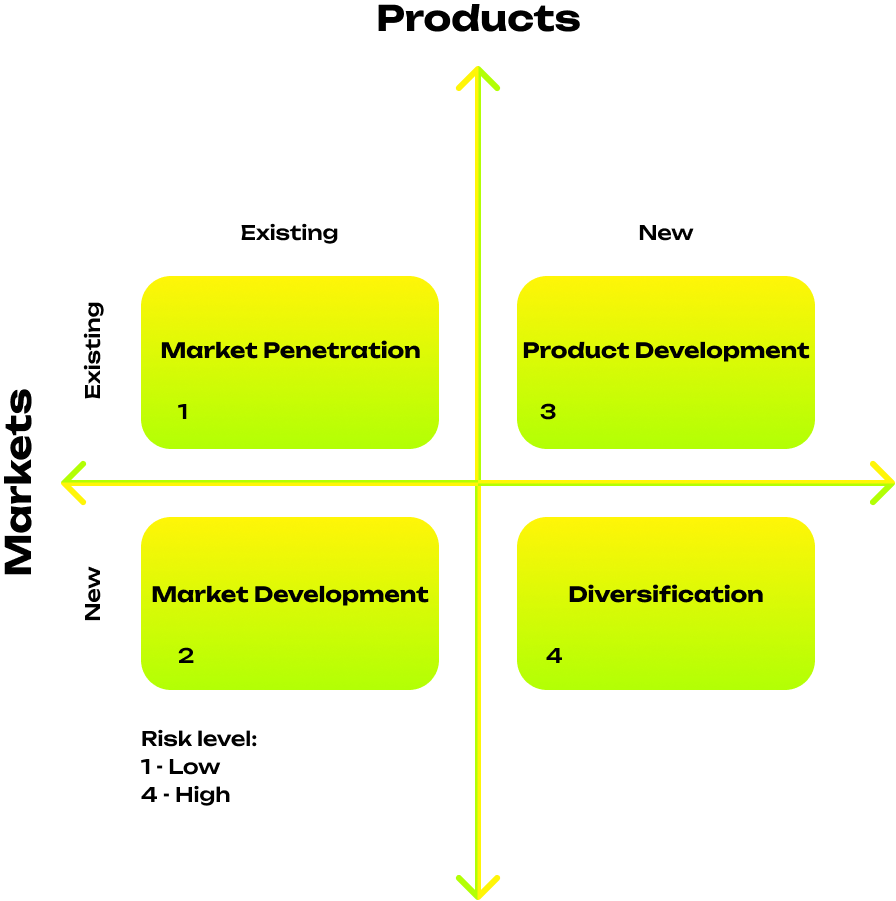What is Ansoff Matrix?
July 6, 2023
278 views
Elementary

The Ansoff Matrix is an effective analytical tool that businesses can utilize to create a development strategy. Igor Ansoff, an American economist, and mathematician of Russian origin proposed it in 1957. Nowadays, the model is now being taught in business schools to marketers, analysts, and managers.
The Ansoff matrix describes potential growth strategies and represents four main segments:
- Existing products and existing market.
- Existing products and new market.
- New product and new market.
- New product and existing market.
Businesses should evaluate what kind of products and markets they deal with and choose the appropriate segment. Four segments correspond to four strategies:
Market development is used when it’s necessary to bring an existing product to a new market.
Product development is used when it’s necessary to launch a new product on the existing market.
Diversification is a strategy for launching new products in a new market.
Market penetration is a strategy to increase sales of existing products in an existing market.

The “Market” in Ansoff Matrix can be defined in different ways. For example, it can be a particular region like the USA, Europe, or Asia. Moreover, customer segments can be defined as markets as well – for instance, divided by income, demographic characteristics, or behavior.
Market Development
This strategy is used in the case when it’s necessary to enter new markets with existing products. Businesses can implement this strategy in the following ways:
- Enter new customer segments.
- Enter new region.
As an example, let’s take a look at Uber’s history. Starting in San Francisco it has rapidly expanded and soon covered all United States. With a single product, Uber successfully entered new markets city by city. Of course, after that new products were brought to the market by Uber, but at the early stage, they successfully implemented a market development strategy.
Market Development is rather risky compared to Market Penetration, as it requires significant investments in the development of a new market.
This strategy fits, if:
- The market is lowly competitive.
- There is a high demand for the product.
- The company has enough resources.
- Products are unique.
Product Development
If a company has a loyal audience it can test its product development strategy. Furthermore, it can be a product of any other manufacturer under the company brand.
The perfect example is the most powerful brand nowadays – Apple. By creating new products every year, Apple successfully used a product development strategy and set new market capitalization records.
This strategy requires investments in product development. If the product will be rejected by the audience it may cause financial losses.
This strategy fits, if:
- The product has drawbacks and requires enhancements.
- The market is highly competitive.
- There is a great chance of new competitors.
- The market requires constant product updates.
- The company has enough resources for the development.
Diversification
Diversification is the riskiest yet potential development strategy. Businesses can create new revenue sources and decrease their dependence on existing products. There are two types of diversification:
Related diversification. For related diversification, it’s typical that new and existing products supplement each other. For example, if a business produces leather shoes, it can also produce leather seats for vehicles. From a single resource hub, a business can produce several products and enter new markets with a new product.
Unrelated diversification. In unrelated diversification new product is not relevant to exist ones. For example, the same shoemaker wants to diversify its dependence on one segment and invests in FMCG goods production.
This strategy fits, if:
- Businesses can’t proceed other three strategies.
- Revenue flow is getting lower, the market is getting tight.
- Businesses can handle the risk.
- New products have more potential than existing.
Market Penetration
The idea of this strategy is pretty simple – to increase sales of existing products in the existing market. The only issue is how to do that. Well, the following actions may help with the implementation of this strategy:
- Increase marketing performance
- Cost reduction
- Business processes optimization
- Sales methods improvement
To understand how it works better let’s take a look at the example. Imagine just an ordinary bar. The bar wants to increase its sales and makes a special Friday promo bring a guest – take a free drink. Of course, both attendees will not stop at one drink and will generate higher revenue for the bar.
This strategy is the least risky compared to the others. Business does not even have to invest in product development or new market entrance, but this does not mean that it is less effective.
This strategy fits, if:
- The business has a small market share.
- The product has unique features.
- The brand is little known.
5 Key Points About Ansoff Matrix
The Ansoff Matrix describes possible business development strategies.
Market development strategy is when existing products are sold to a new audience segment. It requires market research and solid investments for entrance.
Product development strategy is when a new product is sold on the existing market to the existing audience.
A diversification strategy is when new products enter new markets. There are two types of diversification strategies.
Market penetration strategy is when existing products are sold to the existing audience in higher volumes
Subscribe to our newsletter
We send out weekly newsletter with the best marketing tips.




